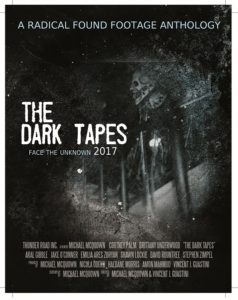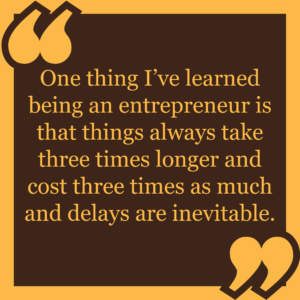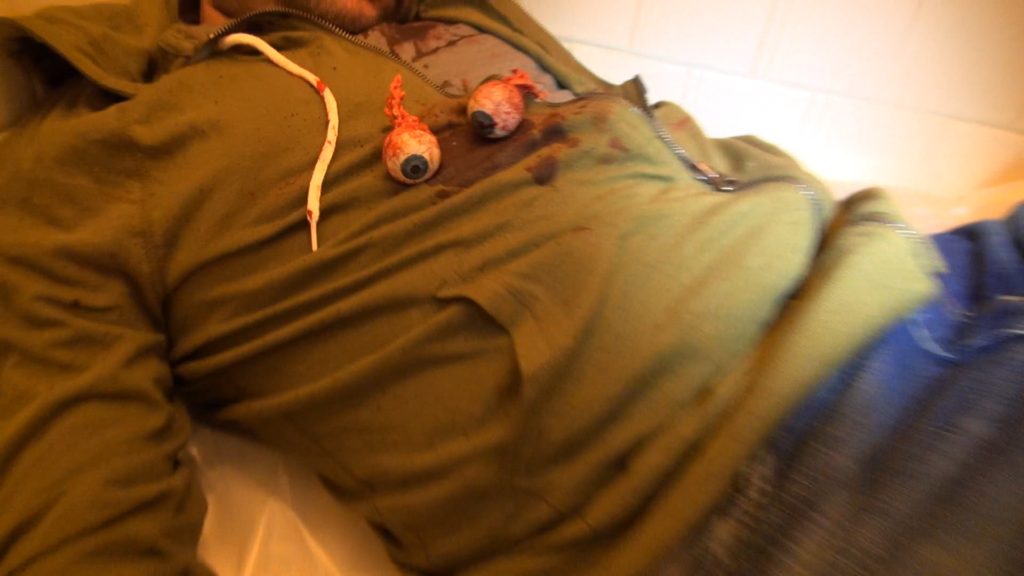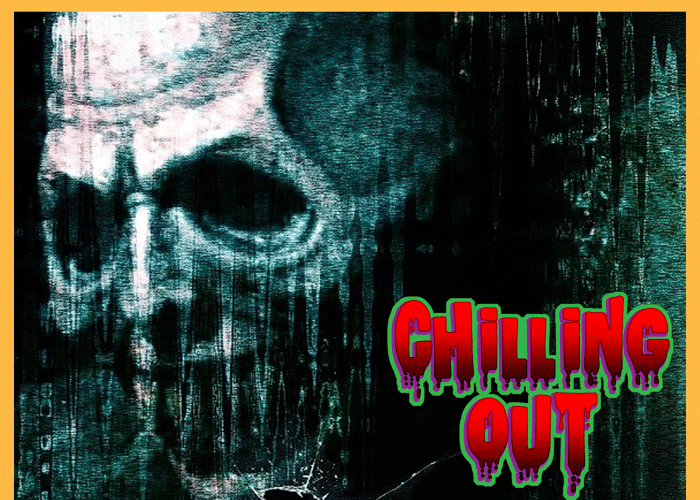 Chilling Out is where TrunkSpace talks all things horror and genre with those who work in the projects that give us the thrills and chills to keep coming back for more. This time out we’re talking with Michael McQuown, writer, producer, and director of “The Dark Tapes,” a found footage horror/sci-fi mashup that has been scaring up fans on the festival circuit.
Chilling Out is where TrunkSpace talks all things horror and genre with those who work in the projects that give us the thrills and chills to keep coming back for more. This time out we’re talking with Michael McQuown, writer, producer, and director of “The Dark Tapes,” a found footage horror/sci-fi mashup that has been scaring up fans on the festival circuit.
We sat down with McQuown to talk about the film’s extended shelf life, stolen furniture, and how the plot all came together in the final hour of production.
TrunkSpace: Horror seems like one of the few genres where you can still build a decent audience by word of mouth alone. From your perspective, is marketing a horror movie different than another genre?
McQuown: Well, I would say yes because the horror people seem to be quite fanatical. They watch everything they can get their hands on. That’s why there’s so much bad horror made because they might have one good gory scene in it and the horror fans will still gobble it up. So you do have a fair amount of genre content being done for a low amount of money because they just know they can make a profit on it and turn it around. Hopefully… hopefully we try to go for something better than that, but people have their own particular tastes.
TrunkSpace: Since the film’s release, what has brought it the most amount of attention and put it on people’s radars?
McQuown: The first festival we got accepted into was the Phoenix Film Festival/International Horror & Sci-Fi Film Festival. That was last April. A few reviews came out of that, I think six of seven, and all but one was positive, and there were some tech issues still to fix on the film. I submitted to a bunch of other festivals too and then we started winning five awards and then 10 awards and then 20 awards. I tried to make as many festivals as I could and I talked to a couple of the festival directors and they were just like, “We really, really love you film.” And I’m like, “Are you sure?” I’m it’s own biggest critic since I know it so well. And they were like, “Trust us… we got X number hundreds of submissions and yours is right there on the top.” And then actually we got into some non-genre film festivals and surprisingly the couple that I attended there, the audience members were actually even more inquisitive than the genre people. They were like, “We normally would never even see a horror film, but we really liked it.” And then the people would quiz me for a half hour or 45 minutes on stuff. So, hopefully it struck a nerve. Now we’re up to 61 awards and nominations, so there definitely seems to be an audience for it. I think that’s spread over 30 festivals and competitions… the 61 awards are. And we’re up to about 50 reviews and all but two are positive, so it seems to be striking a chord with people.
TrunkSpace: Another thing about the horror genre that doesn’t seem to apply to other genres is that it has a longer shelf life. Have you found that to be the case as you’re out supporting “The Dark Tapes?”
McQuown: Yeah. Maybe a model on this is… with a much larger budget, don’t get me wrong… but “The Taking of Deborah Logan.” I’ve checked out its IMDB rankings in the past year and you can see it just had a very long, slow fade from its initial VOD release. That definitely sort of became a word of mouth movie and then it got put on all these top movies of the year lists. So, hopefully that’s the case. We’re with Epic Pictures, just for the U.S., and they do have experience in genre stuff. But, still, we didn’t open in 30 theaters and have all of the reviewers from all those cities reviewing it, so we’re still working diligently on the marketing.
TrunkSpace: You spent many years working on the film. Was there ever a point where you thought it would never get finished?
McQuown: Well, I thought up the idea, basically… and I have said this in other forums… I saw “V/H/S.” One of the producers is a big horror fan and said, “Hey, you should check out ‘V/H/S.’” And actually a couple of weeks before that, the same producer said, “Hey, check out ‘The Pact.’” And I watched that and I thought it was a good movie. I researched it and I was like, “How come I didn’t hear about that?” It was straight to VOD. So I did some research and I found out that the VOD market was something that you could at least break even or make a profit on if you do a quality product and horror was the biggest genre in that market. And then when I saw “V/H/S,” a light went off and I went, “Hey, that’s what I’m going to shoot… a found footage anthology.” The thinking was, if we mess up the first story, we can go back and reshoot it and not have to reshoot a whole feature. (Laughter) And I knew my production costs would be lower, etc. etc. etc. And then when I saw “V/H/S,” I was like, “Yeah, that’s exactly how most found footage films should be done.” They should be done as like a mini feature because a lot of them just have the same problem where you’re sitting through the first 40 to 60 minutes with not much happening.
you’re sitting through the first 40 to 60 minutes with not much happening.
And so we shot “The Hunters & The Hunted,” the first full segment that you see in the film, in October 2013. And the idea was to shoot two other segments and one thing I’ve learned being an entrepreneur is that things always take three times longer and cost three times as much and delays are inevitable. And the delay that we had there… we had a great location and the idea was to rent a place at Airbnb and live at it… myself and the two producers who are also the primary crew members… and we would shoot there as well. So we rented a place and when we showed up, the furniture was gone. And we’re like, “What?!?!” The guy who presented himself as the owner was actually sub-leasing it/renting it on Airbnb and he just decided to steal all of the furniture. (Laughter)
TrunkSpace: Yikes. You can’t plan for something like that!
McQuown: Yeah. It took me about 10 days to find another location that we could live and shoot at. It was in LA so a lot of the owners were like, “Oh yeah, you can do it for $6,000.” I was like, “Well, we might only spend that much on the whole thing.” (Laughter) So, we were only able to do one segment and the two producers, who are British friends and flew out from London, went back. I then went back to Miami and then came out to LA and delayed everything for a year because I had some opportunities to make some more money. So in 2014 nothing was done. And then in 2015 we shot the four stories, one of which is not in the film, but it will be in the DVD as an extra bonus. And it’s not because of the quality or anything like that. I just realized as I was editing that it would push it towards two hours and I felt it would be a stronger film if it was under 100 minutes.
TrunkSpace: That also makes it interesting for people who have already seen the film to give it a second look.
McQuown: Exactly. Right now for people who pre-order and send us a screenshot of their iTunes pre-order, we’ll send them a screener link to the extra story in the summer when I finish editing it.
TrunkSpace: You wore pretty much every conceivable hat in the production of the film. What for you was the most difficult to manage while juggling all of the other duties you had at the same time?
McQuown: I can say the one that is the most time consuming and cumbersome and least creative would be casting. We used a casting director and now I can see the value of a casting director… just in the amount of time you’ll save. The casting director did cast four of the roles. Vincent Guastini, who did the practical effects and directed “To Catch A Demon”… he brought in Cortney Palm. But the rest of the roles, which was like over a dozen, we cast ourselves. We put ads in the right websites and trades in LA and we had probably 3,000 to 4,000 submit. So, that means I got to look through 3,000 to 4,000 headshots online, organize them into the right character, tag them as not good if it’s based on appearance, and now you’re down to 1,000 or 2,000, which I gave to the two producers. They then watched the tapes on the people… 1,000 to 2,000 people. (Laughter) And that got us down to a few hundred people that we scheduled for auditions. And then you’ve got to schedule them, which is a whole cumbersome process because you don’t want people all showing up at once. And then we had to actually book the audition space and go there and set up. It ends up being… that was probably 100 to 200 hours of work between three people to do all of that. So now I certainly see the advantage of the casting director. He already knows who is going to work for that rate that’s up and coming. The people that he brought in all had serious independent film credits. Some had supporting roles for studio stuff. Brittany Underwood was the lead in a Nickelodeon series and she was a well known soap actress for some years. He already knows those people, so for him, it’s probably two hours of work per role. (Laughter) Whereas if you’re going to do it from scratch, it’s 20 hours of work per role.
But I’m perfectly content and happy with the cast. They did a great job. And we got Emilia Ares Zoryan, who is the lead in the wraparound story from “V/H/S Viral,” through our own auditions, so we ended up getting people who had significant credits even through the open casting that we were doing.

I did have something that did help. I did mention that I was the original writer of “The Perfect Man,” which was a romantic comedy that Universal Studios made starring Hilary Duff, which is exactly the type of move that I would never make. (Laughter) I happened to know the person the true story was based on and I thought it would be an easy script sale. And it was. So, I would mention that in the casting listings, so I’m sure that helped us bump up interest a little bit.
But again, the cast was great. We gave them instructions to act very naturalistic because of the found footage nature of the film. And a little interesting note is, in “The Hunters & The Hunted”… because we had the delay with finding the location… that script was really only half done. About half of that was improv. Anytime that the ghost hunters are doing their research, that was all improv. I just told them to watch “Ghost Adventures” and other ghost hunting shows and then we bought actual ghost hunting equipment and the crew and I just hid in a room downstairs. There was one room that never got seen and we’d all just hide there. And it was just like, “Okay… do your thing for an hour.” They had the camera, we had them mic’d up with lavaliers and they just did a bunch of improv.
TrunkSpace: It sounds like the horror version of “Curb your Enthusiasm.”
McQuown: There you go! Exactly. But, it came out really well. And in the DVD we’ll be making an extended version of these scenes we cut out for running time purpose.
TrunkSpace: Some of the best cinematic moments come out of a those moments where an idea or an effect isn’t working and it forces filmmakers to think on their toes and outside the box. Did “The Dark Tapes” have one of those moments?
McQuown: Oh yeah. Absolutely. The demon in “To Catch A Demon” was originally supposed to be on wires and crawling up the wall and crawling on the ceiling and stuff like that. And myself as a first time producer, we had a stunt coordinator bring his whole wire set gear… someone who Vincent Guastini knew… and my fault, I did not have him come to the location to confirm that he could set up all of his wires, which he wasn’t able to because it wasn’t strong enough… the things for him to connect to. So, when we had the whole battle scene at the end with the demon and in other times where you see the demon, he wasn’t supposed to be standing like a person. If he was going to stand like a person, we would have had a different type of practical effect. So, I had to edit around that and the fight scene at the end just wasn’t quite working from what we had shot. He looked too much like a person in a practical effects outfit, which again, he wasn’t supposed to be standing. My fault for not consulting with the stunt coordinator. So we had an extra day of reshooting where we were going to reshoot some of the fight scene and literally with about an hour left to shoot… it just all of a sudden occurred to me that we should have the professor and Cortney Palm’s character Nicole be in multiple, we called it, time dilations, as if they were multiple universes simultaneously with multiple outcomes. I told Vincent, the director, I said, “Yeah… let’s just shoot some scenes of him saying that because then I can go more normal narrative crazy jump cut editing. I can edit anything and anywhere and I’ll make the fight work.” We had bits and pieces of the fight that worked fine, but because of the found nature of the film, you have no cutaways. So, you’re editing choices are very limited. And so literally, it was a very important plot point where he says, “Oh, we’re in multiple time dalations,” and then I realized that “To Catch A Demon” was actually going to be a standalone story. And as I was editing, I was like, “To Catch A Demon” should be the wraparound story, but, “How do I tie it in to the other stories?” At that point I had a way to tie it into “The Hunters & The Hunted” and I had a way to tie it into “Cam Girls,” but I didn’t have a way a way to tie it into “Amanda’s Revenge.” So, again this was all done in the last hour of shooting on one day of reshoots… I pulled David Rountree the actor aside and said, “You’re stuck in multiple time dilations and you’re going to say something worse is coming because you turned on the machine.” And the something worse that are coming are the aliens/demons, whatever you want to think they are, in “Amanda’s Revenge.” And then if you notice the time dates of the stories, that’s why I made “To Catch A Demon” a few years earlier, so then that way the “whatever” that’s coming… it took them time to get here through space because they got the signal from the machine. So, that entire very important plot turn… plot twist… was literally thought up in the last hour of the reshoot to fix the fight scene.

TrunkSpace: So having learned a lot of these first time producer lessons on the fly, what advice would you give to aspiring filmmakers?
McQuown: If I was advising any other filmmakers or people who want to become filmmakers, if you’re going to do it for zero budget… or as I like to say, this film is a negative budget movie because it comes out of my pocket… you’re going to have things come up. If you have skill sets as a good entrepreneur in crisis management… you’ve got to think on your feet and make lemon out of lemonade when it happens. And that’s what happened. We had a fight scene that needed improvement and it led to a critical plot change. We didn’t have time to shoot the wraparound story and instead it became the bookend story, which lead to the “To Catch A Demon” becoming the wraparound story, which ended up tying all of the stuff together better.
Learn more about “The Dark Tapes” here.


